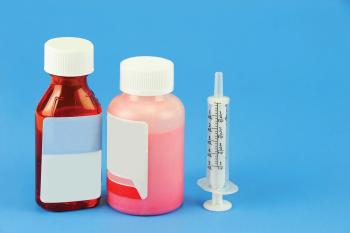
- Pharmaceutical Technology-06-02-2019
- Volume 43
- Issue 6
Considering Connected Inhalation Drug Delivery
A connected MDI may encourage compliance and aid proper technique.
Can “smart” drug-delivery devices improve patient compliance? Innovators at 3M think so. Improving adherence and reducing use errors in noncompliant patients have been associated with improved health outcomes, and smart inhalers have the potential to help accomplish this objective, says Stewart Griffiths, a product commercialization manager for 3M Drug Delivery Systems Division. “As a society, we’re growing more accustomed to getting the information we want faster than ever before and in a way that is tailored to our individual preferences,” he notes. “Everything is personalized and on demand. We are starting to see this becoming true with regard to how drugs are delivered to patients and the instant feedback they expect.” Pharmaceutical Technology spoke with Griffiths about the company’s 3M Intelligent Control Inhaler, which is currently in development, and about some of the manufacturing and regulatory considerations for connected combination drug-device products.
Patient-centric design
PharmTech: Can you briefly describe how the 3M Intelligent Control Inhaler functions?
Griffiths (3M): Most pressurized metered dose inhalers (pMDIs) on the market require you to coordinate your inspiratory flow when you press down on the canister to release the medicine. If you breathe in and your lungs are nearly full by the time you press, you’ve pressed too late. Conversely, you may press too early in the inspiratory cycle. When you mistime it, less medicine than intended is absorbed.
The 3M Intelligent Control Inhaler was designed such that it could utilize the familiar MDI dosage form and add value by aiding patient coordination. It uses breath actuation to help correct the coordination problem, so you just breathe in and the drug is automatically delivered when you are inhaling and before your lungs are full. In addition, the display can visually prompt patients on how to use it correctly. This inhaler has been designed to be reusable. The main electronics component is reusable with up to 12 monthly refills of the medicine.
PharmTech: What are some of the benefits of connecting inhalers to a smart device?
Griffiths (3M): It stands to reason that you can get better patient engagement through ease of use, which can lead to improved compliance. My interpretation of compliance is twofold. The first element is adherence. Is a patient taking his/her medicine at the right time, in the right amount, as prescribed? On a daily basis? Morning and evening? The correct number of puffs each time, as necessary? Are they doing that routinely?
The second element is technique. With inhalation therapy, the delivery of the medicine can be greatly affected by how a patient uses a device. We see many delivery issues with press-and-breathe inhalers, soft mist inhalers, and dry powder inhalers. With some dry powder inhalers, a patient needs to use a lot of inspiratory force to deliver the drug, which is difficult for some patients with respiratory diseases to attain.
Technology can help in both areas. An inhaler that is connected with a smart device can send reminders to a patient to help with adherence, for example. It also has the potential to help improve technique by providing feedback to a patient. The 3M Intelligent Control Inhaler was designed with the potential to do this. We wanted to have the ability to tell patients when they’re not breathing in for long enough or when they’ve not shaken the medicine if it needs to be shaken. Technology gives us the ability to coach and guide patients in the real world, without having to be in a doctor’s office.
PharmTech: How do you incorporate human factors engineering into a device design?
Griffiths (3M): From my perspective, it is important to get the device into the hands of patients as early as possible-for example, through formative human factors studies in the early prototype stage. These studies allow the scientist in the lab to use input from real patients to design new inhalers that are easy to use, fit comfortably in hand, and are easy to actuate, for example. Only when you put it into the hands of patients will you discover that it may be fundamentally flawed. Those formative human factors studies act as inputs that can inform the design of the device. When patients can easily operate a device, it means the patient receives the correct dose and is more likely to comply with the therapy.
One of the key outputs of a human factors program is the instructions for how to use the device. The findings will drive what goes into those instructions. They will also inform how the packaging is designed, to ensure that it is easy for patients to open.
Regulatory considerations
PharmTech: What are the regulatory and data security concerns with connected devices and how are they being addressed?
Griffiths (3M): Protecting patient privacy must be a top priority. There are tremendous opportunities ahead for collecting, sharing, and analyzing data generated by digital delivery devices; however, we need to instill trust in patients from the very beginning. To do that, we need to make sure patients understand how and why we’re using their data, and we need to clearly demonstrate how they will benefit from the use of their data. Today, it is critically important to determine the data strategy before going into design and development. 3M has addressed this by making security part of the up-front development process.
Finally, regulations around drugs and devices are now becoming intertwined with electronics and software. 3M’s goal is to be ahead of the curve and follow the regulations as they evolve. The speed of electronics and software evolution is at a much faster pace than traditional pharmaceuticals by nature. The industry needs to evolve to incorporate electronics but continue in a safe way.
PharmTech: What are some of the manufacturing challenges for incorporating electronics into inhalers? Are there special regulatory/quality testing considerations for connected devices?
Griffiths (3M): From a manufacturing point of view, the arrival of connected devices requires a shift from purely plastic components to the incorporation of electronic components. This not only requires updates to the manufacturing lines themselves, but to the testing facilities. If historically you’ve worked only with plastic materials, tests are purely physical in nature. Electronics module testing is very different. For instance, if your connected inhaler utilizes Bluetooth technology, electromagnetic compatibility testing is required to prevent the device from interfering with other connected devices. Regulatory standards also change, once a device is categorized as connected.
Finally, with technology constantly changing, the use of electronics allows for rapid improvements and the ability to address real patient issues. For instance, improved battery technology can allow a device to be used for a longer period of time. At the same time, it is important to keep in mind that the pace of the pharmaceutical industry is very different than the pace of the technology industry. This can create major challenges on everything from the design to the manufacture of a device.
Article Details
Pharmaceutical Technology
Vol. 43, No. 6
June 2019
Pages: 27–28
Citation
When referring to this article, please cite it as J. Markarian, “Considering Connected Inhalation Drug Delivery,” Pharmaceutical Technology 43 (6) 2019.
Articles in this issue
over 6 years ago
Hovione Technology Develops Blister-Based Inhalerover 6 years ago
Enabling Technologies Advance Poorly Soluble Highly Potent APIsover 6 years ago
Pharma Facilities Still Have a Lot to Learnover 6 years ago
Filling the Early Intermediate Security Gapover 6 years ago
As Easy as ABC?over 6 years ago
Regulating Cannabis-Based Medicines in Europeover 6 years ago
Supply Chain Risk and Security Maturity Evolutionover 6 years ago
On the Right Trackover 6 years ago
Looking Beyond the Solubility Horizonover 6 years ago
Enhancing Bioavailability with Hot-Melt ExtrusionNewsletter
Get the essential updates shaping the future of pharma manufacturing and compliance—subscribe today to Pharmaceutical Technology and never miss a breakthrough.




